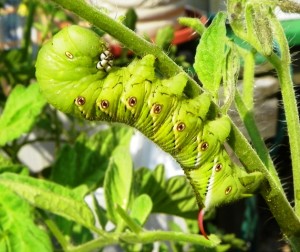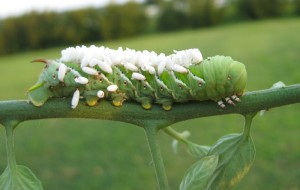What Is Eating My Tomato Plant?
go.ncsu.edu/readext?227129
en Español / em Português
El inglés es el idioma de control de esta página. En la medida en que haya algún conflicto entre la traducción al inglés y la traducción, el inglés prevalece.
Al hacer clic en el enlace de traducción se activa un servicio de traducción gratuito para convertir la página al español. Al igual que con cualquier traducción por Internet, la conversión no es sensible al contexto y puede que no traduzca el texto en su significado original. NC State Extension no garantiza la exactitud del texto traducido. Por favor, tenga en cuenta que algunas aplicaciones y/o servicios pueden no funcionar como se espera cuando se traducen.
Português
Inglês é o idioma de controle desta página. Na medida que haja algum conflito entre o texto original em Inglês e a tradução, o Inglês prevalece.
Ao clicar no link de tradução, um serviço gratuito de tradução será ativado para converter a página para o Português. Como em qualquer tradução pela internet, a conversão não é sensivel ao contexto e pode não ocorrer a tradução para o significado orginal. O serviço de Extensão da Carolina do Norte (NC State Extension) não garante a exatidão do texto traduzido. Por favor, observe que algumas funções ou serviços podem não funcionar como esperado após a tradução.
English
English is the controlling language of this page. To the extent there is any conflict between the English text and the translation, English controls.
Clicking on the translation link activates a free translation service to convert the page to Spanish. As with any Internet translation, the conversion is not context-sensitive and may not translate the text to its original meaning. NC State Extension does not guarantee the accuracy of the translated text. Please note that some applications and/or services may not function as expected when translated.
Collapse ▲Are leaves suddenly disappearing from your tomato plant? Take a closer look. Your plant is probably being attacked by hornworms. Despite their large size, these bright green caterpillars can easily hide among tomato leaves, staying out of sight until they have eaten most of the plant’s foliage. Inspect your plants for hornworms now before they strip it down to bare stems.
IDENTIFYING HORNWORMS
Tomato and tobacco hornworms are closely related large, bright green caterpillars that feed on the leaves of tomatoes, as well as angel trumpet (Brugmansia and Datura species), tobacco, eggplant and occasionally peppers. They have a distinct single spine or “horn” on their rear end, but cannot sting. These caterpillars will reach up to four inches in length before maturing into large grey moths.
Despite their large size, hornworms are not usually noticed until they strip a considerable amount of foliage from a tomato plant, which can happen in a matter of a few days if several caterpillars are feeding on the same plant. If left unchecked, hornworms can devour all of a tomato plant’s foliage, severely weakening the plant. Hornworms will continue to multiply through the rest of the growing season, making control now and throughout the summer essential to keep your tomatoes productive.
CONTROL OPTIONS
One of the simplest methods for controlling hornworms, as well as many types of insects, is to pick them off plants and drop them into a bucket of soapy water. Controlling hornworms by hand picking requires almost daily inspection to stay on top of the population. Adult hornworms, known as sphinx moths, lay new eggs every night, and each female can lay up to 2000 eggs during her short life span.
A less labor intensive way of controlling hornworms is to spray tomato plants with an appropriate insect control product. Several insecticides are effective, with products containing organic and synthetic active ingredients available at local garden centers. When applying any insecticide be sure to read and follow all label directions and pay careful attention to the pre harvest interval. This is the number of days you must wait between the time you spray the plant and the time you harvest. Pre harvest intervals vary among insecticides from 0 to 21 days or more. If you already have ripening fruit on your tomato plants, be sure to choose a product with a short pre harvest interval.
ORGANIC PRODUCTS
Organic insecticides that control hornworms and other caterpillars include Bacillus thuringiensis, a bacterial disease that only effects caterpillars and is commonly referred to as B.t. B.t. is sold as Dipel, Thuricide, and several other brand names, and is most effective if applied when caterpillars are small. Spinosad is another option for controlling caterpillars organically. Derived from a soil dwelling bacterium, spinosad is the active ingredient in several insecticides, including Captain Jack’s Dead Bug Brew and Greenlight Spinosad Lawn and Garden Spray. Additional organic control options include products containing neem or pyrethrins. Because they break down quickly, most organic pesticides need to be reapplied more often than synthetic sprays to maintain plant protection. Check product labeling for application timing recommendations and restrictions.
SYNTHETIC PRODUCTS
Synthetic insecticides that control caterpillars include products containing one of the following active ingredients: carbaryl (commonly sold as Sevin), cyfluthrin, permethrin, and bifenthrin. Active ingredients of all pesticides are listed on the product container and can usually be found on the front of the packaging. When treating tomatoes and other garden plants, be sure to only use products that are labeled for spraying vegetables. Spray late in the evening to minimize impacts on bees and other pollinators.
BENEFICIAL INSECTS
Gardeners occasionally find hornworms in their garden that have white cylindrical attachments all over their backs. These are the cocoons of a type of parasitic wasp, which feed on caterpillars as they develop, eventually causing them to die. Parasitic wasps are very small and do not sting people. If you find a caterpillar in your garden that has been attacked by parasitic wasps, leave it there so the wasps may continue to develop. When mature they will hatch out of the cocoons and seek new caterpillars to prey upon.
LEARN MORE
Other common summer tomato problems include wilt diseases, leaf spot diseases, and fruit rots. If you suspect your tomatoes have a disease or insect problem, have the cause correctly diagnosed before taking any action. Visit Texas Cooperative Extension’s Tomato Problem Solver website, http://aggie-horticulture.tamu.edu/vegetable/tomato-problem-solver/, to diagnose your tomato problems.
Learn more about tomato insect pests and diseases from these Clemson Extension fact sheets:
- Insect Pests of Tomatoes: http://www.clemson.edu/extension/hgic/pests/plant_pests/veg_fruit/hgic2218.html
- Diseases of Tomatoes: http://www.clemson.edu/extension/hgic/pests/plant_pests/veg_fruit/hgic2217.html
Learn more about natural pest control and related topics from these recent Pender Gardener articles:
Visit your local Cooperative Extension office to learn more about gardening and landscape care. Go to https://www.ces.ncsu.edu/local-county-center/ to find your county Extension center.
- If you live in Pender County, call 910-259-1235
- In New Hanover County, call 910-798-7660
- In Brunswick County, call 910-253-2610
- In Onslow County, call 910-455-5873
- In Duplin County, call 910-296-2143





